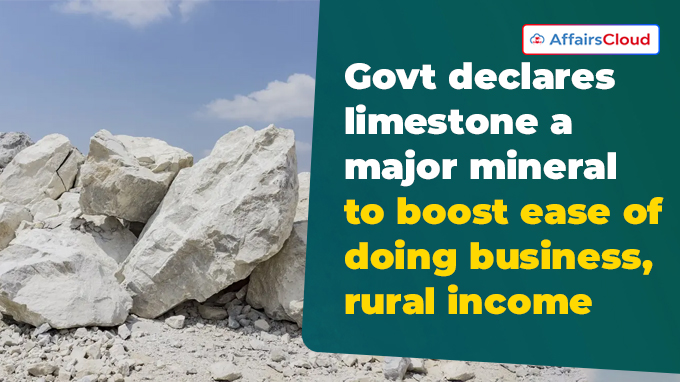In October 2025, the Ministry of Mines (MoM) officially reclassified ‘Limestone’ as a ‘Major Mineral’ by removing end-use restrictions and issued a notification under Section 20A of the Mines and Minerals Development and Regulation Act, 1957 (MMDR Act, 1957), to ensure a smooth transition of existing minor mineral limestone leases to major mineral leases.
Exam Hints:
- What? Classification of Limestone
- To: Major Mineral (from Minor Mineral)
- Classified by: MoM
- Act: Section 20A of MMDR Act, 1957
- Key Changes for Leaseholders:
- Register with IBM & pay royalty at existing rates till March 31, 2026
- Existing mining plans valid till March 31, 2027
- Key Exemptions:
- Filing digital aerial images & online self-assessment reports till July 1, 2027
- No penalty for non-filing of monthly/annual returns till March 31, 2026
Background:
Previous Classification: Limestone was categorized as a minor mineral when used in kilns for manufacturing lime as a building material.
Recommended by: The decision was based on recommendations from an Inter-Ministerial Committee on Mines & Minerals Sector, chaired by a Member of National Institution for Transforming India (NITI) Aayog, which engaged with various stakeholders.
Significance: This classification of limestone as major mineral will enable the leaseholders to freely sell the mineral to cement and other industries, which will boost rural incomes and promote ease of doing business.
Key Directions:
Transition for Existing Leaseholders: Existing minor mineral limestone leaseholders must register with the Indian Bureau of Mines (IBM) and continue paying royalty at current state-specified rates until March 31, 2026.
Validity of Mining Plans: Existing mining plans approved by state governments will remain valid until March 31, 2027, after which fresh approvals must be obtained.
Exemption from Digital Compliance: The MoM has exempted leaseholders from submitting digital aerial images of mining areas and online self-assessment reports under the star rating template until July 1, 2027.
Exemption from Penalty: No penalty will be imposed for non-filing of monthly and annual returns to IBM under Rule 45 of MCDR, 2017, until March 31, 2026, provided lessees continue submitting returns to the state governments.
Pending Applications: The MoM clarified that pending limestone applications with a Letter of Intent (LoI) or completed auction before October 10, 2025, will be granted leases under existing state rules within two years, while applications without an LoI will lapse.
About Minerals:
Definition: Minerals are valuable natural resource of organic and non-organic nature, with unique chemical and physical properties.
Classification: MoM has classified minerals found in India, into two main categories such as: Major Mineral and Minor Mineral.
Major Minerals: These minerals are specified in the Schedule-I of MMDR Act, 1957. The major minerals are further classified into 3 sub-categories such as:
- Fuel Minerals: These include coal, lignite, natural gas, petroleum (crude).
- Metallic Minerals: Bauxite, Chromite, Copper Ore, Gold, Silver, Iron Ore, among others.
- Non-Metallic Minerals: Quartz, Pyrites, Barytes, Diamond, Dolomite, Gypsum, among others.
Minor Minerals: As per the section 3(e) of MMDR Act, 1957, ‘minor minerals’ mean building stones, gravel, ordinary clay, ordinary sand other than sand used for prescriber purposes. The Central Government has the authority to declare ‘minor minerals’ under section I (a) of MMDR Act, 1957.
- Some of the minor minerals are: Sand Stone, Marble and Salt Petre, Bentonite, Granite, Laterite, Shingle, among others.
About Ministry of Mines (MoM):
Union Minister- Gangapuram (G.)Kishan Reddy (Constituency- Secunderabad, Telangana)
Minister of State (MoS)- Satish Chandra Dubey (Rajya Sabha- Bihar)





